5 Module 5 – The Patient’s Unit
The Patient’s Unit
Learning Objectives
- Demonstrate understanding of what makes a safe and healthy environment
- Understand what pieces of equipment are always present in a resident room
- Demonstrate understanding of positioning techniques
- Demonstrate proper placement of linen on bed
- Understand the nursing assistant’s role in admissions, transfers, and discharges
What makes for a safe and healthy environment?
Physical & emotional wellbeing
This module is all about what makes a resident or patient’s environment safe, healthy, and comfortable. All three points of the Big Three will be necessary.
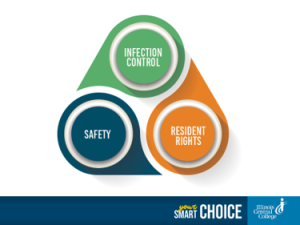
A person is comfortable at a basic level when they are physically safe, free from pain, and emotionally well.
There are many things that go in to making a person’s environment comfortable. NAs should make environments as comfortable as possible and give people agency over aspects of the room like temperature, lighting, and airflow.
Emotional comfort and safety can be as impactful as physical comfort on a person’s overall wellbeing. This is an especially important consideration for NAs working in long-term care facilities. Unsettling and difficult changes can occur when moving into or remaining in a facility, and the decision to do so was probably difficult and may follow an adverse medical event.
Sometimes people have been separated from their loved ones. Most people moving into a care facility will need time to process this drastic change. Perhaps they fear loss of independence, or a sense of loneliness.
NAs can help make a person’s environment comfortable by being available to talk and to keep them company. NAs should emphasize that they are a kind presence and are excited to form a caring and friendly relationship with the person.
Comfort and Resident Rights
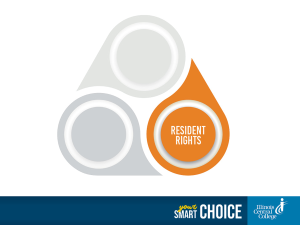
Residents have a right to a comfortable and home-like environment.
Temperature, ventilation, noise levels, and lighting are part of the patient’s unit that directly impact their basic comfort[1].
- Is the room too hot or cold? It must be between 71 and 81 degrees.
- Is there adequate air circulation and fresh air?
- Does the resident need more sound isolation, or perhaps would they like some music? Is the overhead lighting too harsh or can it be dimmed?
Temperature: Rooms must be kept at a comfortable temperature. OBRA requires that all rooms be kept between 71 and 81 degrees Fahrenheit[2], and residents should decide to where in that range the thermostat is set.
If someone is still too warm at 71 degrees, or too cold at 81 degrees, other strategies such as fans or layering clothes and blankets may be necessary. If someone is sick, elderly, or an infant, then they are susceptible to drafts, or cold breezes; they should be clothed to offer some protection from chill, offered robes, blankets, and moved to warmer areas of the facility.
Odor: Unpleasant odors are common in healthcare settings; bodies themselves produce materials that can exude offensive odors (waste, wounds, and vomitus), and some people may find peoples’ body odors, breath, or lingering smoking odors difficult to be around.
NAs that smoke should not smoke in their uniform. They should keep their hair odor-free, and consider a solution such as gum or mouthwash to assist with breath odor.
To reduce other odors, provide attentive care, and maintain good ventilation and housekeeping practices. For example, to reduce odors in a room with someone who is incontinent, change the resident’s incontinence briefs regularly.
Soiled linens and unclean objects should be changed or cleaned as quickly as possible to prevent the buildup of unpleasant odors. If possible, NAs can open a window to improve ventilation and let in some fresh air. If nothing else seems to be working, facilities may keep spray deodorizer on hand for tenacious odors.
Noise: When someone is not feeling well, is trying to sleep, or is undergoing any form of emotional stress, then loud or unexpected noises can pose a disruption. For example, imagine being desperately tired and not being able to fall asleep, and then just when you are starting to doze off, a loud beeping sound from outside your door jolts you awake.
Keeping a controlled noise level in medical facilities can be difficult, but it is important to peoples’ care, especially when they are trying to rest. To minimize unwanted noise, speak conscientiously and at a measured volume.
Equipment can also be a source of unwanted noise; NAs should always handle equipment carefully and keep it in good working order so the machines don’t make unnecessary disruptive noises.
Answer the phone, patient call lights, and intercoms promptly; this is both because patient needs should be met with haste, and because addressing these indicators promptly prevents anybody from needing to hear them a second time.
Lighting: Lighting is an important feature of overall comfort. If a room’s lighting doesn’t meet a person’s needs, it can be frustrating and stressful. Rooms should be well-lit and kept cheerful and engaging during the day, especially if the room’s resident is hard of sight at all. People with poor vision need clear and bright lighting. Lights should be dimmed when the resident is trying to rest.
Equipment in residents’ rooms
Residents’ rooms are their rooms, and they have a right to privacy. These rooms are their living spaces and must be treated as such.
- Always knock before entering a resident’s room.
- Announce your presence clearly.
- Never rearrange any of the room’s contents without discussing it with the resident first. Residents should be encouraged to fill their space with personal belongings to make them happy and feel at home.
Residents’ rooms always come equipped with some basic equipment. It is important for NAs to know what each piece of equipment is and what it is for. While some pieces of equipment will differ from facility to facility, these basic items will be present in all healthcare facilities[4].
- Bedside stand: For storage, and a table surface. Urinals and bedpans are kept in the lower compartment of the bedside stand, while personal care items like toothbrushes are kept in the top shelf or the drawer. It is very important that personal care items are kept separate from the items used for waste elimination and disposal. Items such as the telephone or personal objects like a book can be kept on the surface of the beside table.
- Dresser/closet: Residents have a right to free access to a closet and drawer space. They must always have free access to the space and all of its contents. Always ask the resident’s permission to open and search any closet and drawer space.
- Overbed table: This is a tall table surface, usually on wheels, intended to help people remain in bed while eating. The surface may also be used for another activity like using a laptop computer, reading a book, or providing personal care like brushing one’s teeth.
- The overbed table is a clean surface, and should be disinfected and kept free of clutter. Bedpans, urinals, and used linens should never be placed on the overbed table because people use the overbed table to eat. Clean the overbed table before a meal.
- Chair: Each unit has a chair for the patient and their visitors to use. The chair must be sturdy, stable, comfortable, and relatively easy to get in and out of. Residents in nursing centers can also bring furniture from home.
- Privacy curtain: Privacy curtains should be pulled all the way closed whenever administering care, when the person is sleeping, whenever the person is exposed or vulnerable, and whenever the person wants it closed. Sometimes it is okay to leave the curtain open halfway upon the person’s request.
- Personal care items: Personal care items are items that are used for hygiene and elimination.
All agencies provide a bedpan and urinal, in addition to wash basins, an emesis basin, water pitcher and cup, soap, and a soap dish. Some agencies may also provide lotions, toothbrush and toothpaste, mouthwash, tissues, or a comb.
- Call light: A call light is a button that a patient or resident can press that alerts the nursing team that they need assistance. It is also called a signal light. NAs need to think of the call light system as a patient’s lifeline; they may be calling because they are in pain and need to be repositioned, or they could be calling because they are having an immediate medical emergency and require prompt assistance.
- Never ignore call lights, even from someone you’re not assigned to care for; ignoring a call light can be considered an abusive or negligent behavior, and can result in administrative trouble, as well as serious medical consequences for the person calling.
- Call light buttons should always be left within easy reach while the NA is out of the room.
- Bathrooms and showers have specific call lights that must be answered immediately, because they may indicate that a person has fallen and needs assistance right away.
- Depending on the person’s hand and wrist mobility, special signal lights may be required. Some people are unable to use call lights; NAs should make sure that they are up-to-date on the care plan for patients like this, and should make sure to check on them often.
- Bed: Beds are the place where residents will spend the most amount of time. A clean and well-made bed prevents skin breakdown and pressure injuries because a smooth bed minimizes friction and helps to evenly distribute pressure. All beds will be able to move and be height-adjustable; some beds may have additional capabilities[5]. This makes bed-making an important dimension of infection control; by minimizing skin contusions and sores, there are fewer points of entry for pathogens.
Personal possessions
Residents may have their personal possessions with them in long-term care. NAs must always treat these personal items with the utmost respect; never handle them without asking.
These items may be a resident’s only daily connection to their life before or outside of the nursing facility. NAs can use these personal items as conversation starters when appropriate.
(Re)Positioning
The importance of repositioning
Repositioning a person is necessary for maintaining basic physical health. It promotes circulation, comfort, and helps prevent pressure injuries. It is essential for holistic, person-centered care[6].
Regular repositioning of residents, particularly those that are incapable of repositioning themselves, is necessary for promoting comfort and overall wellbeing.
Repositioning prevents any one part of the body from having an undue level of pressure or friction on it for extended periods and becoming sore. Repositioning also promotes good breathing and general body alignment.
- It is necessary for healthy blood-flow
- Prevents the forming of pressure ulcers
- Promotes muscle health by preventing contractures, and protects mobility when contractures do occur.
Safety
Safely positioning someone requires good body mechanics. Review the section on body mechanics in Module 3 for more information on the importance of body mechanics and alignment (Safety is one of the Big Three!). Always ask for help if unsure that you can reposition someone safely and comfortably. 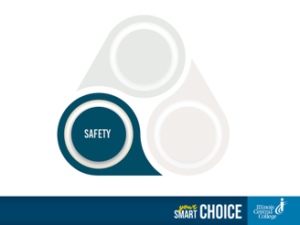
While repositioning someone, keep in mind the possibility of unintentionally producing feelings of psychological discomfort, vulnerability, or simply awkwardness. Always explain the procedure in detail before and as you are doing it.
It is important to reposition people slowly and gently. Be cautious and don’t make sudden or unthoughtful moves. Always provide for privacy by using the privacy curtain.
Make sure that the person is comfortable once they have been repositioned by asking if there is anything you can get them, or providing an adjustment if the person could be positioned more comfortably; sometimes assistive devices will be used to help keep a person in the proper position, but only at the direction of a nurse.
Always keep the signal light within the person’s reach. Different positions can create different ranges of motion. It is the NA’s job to make sure that whatever position the person is in that they always have easy access to the signal light.
Video by Allie Tiller is licensed under CC BY-NC 4.0
Positions
Positioning someone in a way that is as comfortable as possible for them will likely require some fine adjustments. However, there are seven basic positions NAs will use to keep circulation flowing and minimize the risk of pressure injuries for people who spend most of the time in bed.
- Fowler’s: Fowler’s position is a semi-sitting position where the person’s bed in inclined to between 45 and 60 degrees, and the person’s legs may be elevated with a pillow or a rolled blanket. The person may also just keep their legs flexed. Semi-Fowler’s is a position where the bed is only slightly angled.
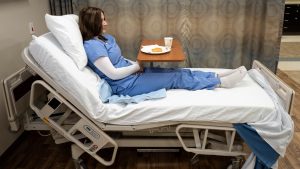
Picture by Allie Tiller is licensed under CC BY-NC 4.0
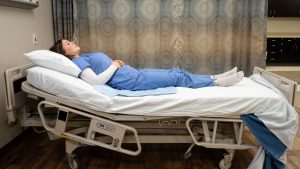
Picture by Allie Tiller is licensed under CC BY-NC 4.0
- Supine: Supine position is when someone is lying on their back with their calves supported by a pillow or blanket so the heels remain slightly elevated. NAs can use supports under arms, legs, ankles, and hands for people with weak muscles. Always maintain healthy alignment.
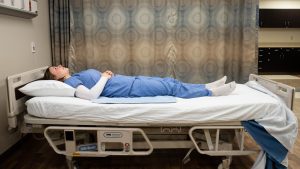
Photo by Allie Tiller is licensed under CC BY-NC 4.0
- Prone: Prone position is when a person lies flat on their abdomen and front with their head turned to one side and their arms palms-up at their sides. Only place people in this position as directed by them, since it can be uncomfortable or painful for some people.
- Lateral: Lateral position is when someone lies on their side. This position is variable and allows for various different positions. Usually, a person’s top knee will be bent and supported by a pillow. Their top arm will likely fall over their front side, and can also be supported. Pillows or blankets can be used to separate the legs and ankles to prevent any friction and skin breakdown.
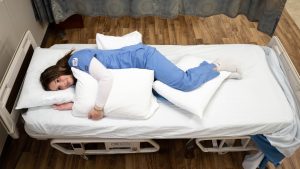
Photo by Allie Tiller is licensed under CC BY-NC 4.0
- Sims’: Sims’ position is a semi-prone, left-side lying position where the right knee is bent towards the person’s chest and supported with a pillow. Their lower arm is bent slightly behind their back at the shoulder and is left palm-up. Toes and ankles should be elevated from the bed using pillows.
- Trendelenburg: Trendelenburg position is when someone’s body is lying flat, but the surface they lay on is angled so their head is lowered and their feet are raised. This position is only used according to doctors’ orders.
- Reverse Trendelenburg: Reverse Trendelenburg is the same as the Trendelenburg position, except the feet are lowered while the head is raised. This position can only be used according to doctors’ orders.
Repositioning in chairs
People who sit in chairs must be able to hold their head and upper bodies upright. If a person cannot support their own body weight then their alignment will be compromised and they may be injured. If a person cannot support their own weight due to age or disability then assistive devices may be put in place to maintain their alignment and posture.
- A person’s feet should be flat, placed either on the floor or, if using a wheelchair, on the wheelchair’s footplates. The person’s calves and backs of their knees should fall slightly away from the seat.
- Always optimize the resident’s safety, dignity, and functioning in repositioning people.
- Use time spent repositioning someone as an opportunity to check in about how they are feeling, provide some company and human support, and tend to the holistic dimensions of the person’s care.
Admission, transfer, and discharge
NAs will play particular roles during the admission, transfer, and discharge of people within healthcare settings. Admission, transfer, and discharge are three common instances when a person’s administrative status changes[7].
Admission occurs when someone enters a facility for care, transfer occurs when a person changes facilities or changes their room within a facility, and discharge is when a person leaves the facility to continue care at home. While these all require different processes, there are points of similarity across all three. Admission, transfer, and discharge all require:
- Privacy and confidentiality throughout the process
- Meticulous reporting and recording
- Understanding the person and their needs, and knowing how to communicate with them effectively
- Consistent communication with the rest of the health team
- Respect for the person and their property. Whether facilitating an admission, transfer, or a discharge, the person’s belongings should be treated with the highest level of respect. These belongings may be the person’s primary way of feeling connected to their life outside of the healthcare facility.
- Being kind, courteous, and respectful of all participants at all times, especially the person receiving care. NAs should always take the time to explain what is happening, to offer moments of human connection and conversation, and to answer any questions (that they can or are permitted to answer) that the person may have.
- Patience and empathy are key considerations during admission, transfer, and discharge.
Admission
Admission is the official entry of a person into a healthcare setting in the position of a patient or a resident. Healthcare staff must be welcoming and kind during all of their interactions, but it is especially important during admission.
During admissions patients, residents, and their families are likely in a new setting that may be strange to them; perhaps they have concerns and fears about the quality of care or the social environment that they are entering into. They are likely there because of an adverse event, or because of an increasing loss of independence. The admission process should be conducted kindly and with a positive and welcoming tone.
The process
Admission will usually begin in the admitting office and will include obtaining the person’s full name, age and birthdate, their regular doctor’s name, their Medicare and/or insurance numbers, and their religion. NAs should prepare the person’s room before they arrive, so that all that is left is for the person to move in.
A nurse will greet and escort the person and their family to the person’s room, though the NA may be asked to admit them if they are all doing well. The nurse or admitting person will complete the admission paperwork with the person and/or their family, so there is no confusion and so the paperwork does not become its own source of stress and anxiety.
Admission is the NAs first chance to make a good impression, and first impressions only happen once.
- Always greet the person by their name and title (i.e. “Mr. Jones” or “Miss Gupta” or “Dr. Ali”).
- Introduce new patients or residents to their roommates if they have them.
- Always treat the person with dignity and respect throughout the admissions process; newcomers in a care setting are experiencing a complicated array of emotions, and it is an important aspect of holist care for someone to feel comfortable and at-home.
- It is important to properly orient the person to their room, the nursing unit, and the general agency or facility. Provide newly admitted residents a tour of the space and facilitate introductions to other patients, residents, and staff.
Collecting basic information
Admission will involve collecting some basic medical and personal information. For instance, NAs will measure the person’s weight and vital signs. They should also complete a list of the person’s personal belongings and clothing items. Any valuables should be listed and either sent back to the person’s home or placed in a safe in their room.
- When taking a person’s height and weight measurement, it is important to be as respectful as possible. Many people do not like having measurements taken, as it can produce feelings of vulnerability and scrutiny. Always treat the person with dignity and a professional demeanor, and honor any of their wishes about how they would like their height and weight taken.
- It is unnecessary for the NA to announce anybody’s physical measurements of any kind, as they can observe and take note without saying anything out loud. Just take the note and move on, unless they specifically ask “how much do I weigh?”
- A person will be weighed at different intervals depending on their care plan to measure any weight gain or loss, since weight gain or loss is a relevant change in a person’s condition.
- Different scales will be used depending on the person’s mobility; for example, scales are often made to be stood upon, but there are also scales specifically designed to be used in a chair, wheelchair, bed, or mechanical lift. Some beds even come with features to measure their occupant’s weight.
While obtaining a persons’ weight, follow these guidelines to ensure accurate readings of weight gain or loss:
- Have the person wear the same or similar clothing they wore when weighed prior, and have them remove their footwear.
- Use the same scale.
- Weigh the person at the same time of day.
- Have the person void before being weighed if they can. If the person wears an incontinence brief, make sure that it is dry.
Care planning
Once a person is admitted there will be a care planning process where they set care goals in communication with the health care team members. Care plan re-evaluations will occur periodically throughout the person’s stay in the facility.
Care planning involves all members of the care team developing a plan for the person to meet their health goals; care goals should be attainable and possible to achieve within a reasonable time frame. Residents have a right to participate in all care conferences.
Care planning follows the Nursing Process (assessment, nursing diagnosis, goal, implementation, evaluation). While NAs are necessary at every step, they are most essential to the assessment phase because they are in the best position to gather information and notice subtle changes in a person’s condition day-to-day. Assessment is an ongoing process, and never ends no matter which phase of the nursing process the team is also working on. Getting to know residents on an individual level is essential for accurate assessment.
Transfer
Transferring a person involves moving them to another healthcare setting, such as from the hospital to a transitionary care facility before they can go back home. In some agencies, transfers will occur when a person is moved to a new room or a different area of the facility; an example might include an assisted living resident being transferred from their usual unit to a unit of the facility dedicated to memory care and residents with dementia and Alzheimer’s.
Another example may be transferring someone into hospice care once a doctor determines that their condition is immanently terminal. Transfers can occur because of a change in someone’s condition, or because there has been a change in someone’s care needs. They can also occur because the person requests a new room for their own reasons, or if the roommates in a given room do not get along.
The process
Transfers between rooms or facilities can be quite the operation; in addition to moving the person, all of their objects will also be moved. The person’s family can assist with this, especially if the person being transferred is moving from one elder care nursing facility to another.
NAs can use thoughtful communication skill to support and reassure the person during transfer. People can become stressed and anxious during transfer, especially if they are already prone to confusion or disorientation. Avoid clichés like “it’s going to be okay” when responding to patient’s or resident’s worries. Such responses can feel prepackaged, belittling, and designed to appease. Instead, genuinely listen to the person’s concerns, and validate their concerns without telling un-truth or increasing their worry. Sometimes it can help a person just to know that the NA is there and is caring for them, while others may need more involved conversation to be put at ease.
When the person is in their new room or unit, NAs orient them to the physical and social space. They can give the person a tour, introduce them to their roommate, and introduce them to the other facility staff.
Some transfers will involve the person leaving the agency and being transferred to a different agency. In such cases, the person is always involved in the transfer planning process, and the transfer-plan is discussed and laid out by the healthcare team in advance.
The nurse will alert the NA as to when it is time to start the transfer process. Only a doctor can give the order for somebody to be transferred out of the facility. If the person wants to leave the facility, the NA should tell the nurse as soon as possible. The nurse or a medical social worker will handle situations where a person is requesting or demanding to leave before the doctor has issued the order.
Discharge
Discharge occurs when someone is officially released from the care of the hospital or medical facility. This is usually a happy time for people and their families. The person may have reached their care goal. Sometimes a person will be released home and need continued home health care.
When a person is discharged, the healthcare team will give the family any information about diet and nutrition, exercise and activity, medications, and required procedures and treatments so that the person maintains continuity of care between the facility and their healthcare at home.
If necessary, discharge time is when home healthcare assistance is arranged for, as well as any special medical equipment and therapies the person requires. A follow-up doctor’s appointment will be scheduled at the time of discharge.
When a person is discharged, all of their belongings are placed in a bag that goes with the person. NAs should make sure that all of the person’s belongings and anything else they entered the facility with make it into the bag. If the person’s family cannot transport them, the nurse or social worker will have transportation arrangements made. Many facilities, especially hospitals, have their own vehicles and transportation services available.
Once the person has moved out of their room, NAs may be requested to remove all linens and any care items from the room before housekeeping arrives to clean it for the next occupant.
Bed linens
Beds are extremely important places for residents in long-term care facilities; some of them will spend all or most of their day in bed. In most nursing centers, a complete linen change will be done 1 – 2 times per week, usually on the day that the person is bathed. A person’s linen is usually changed on the same day that they take a bath because if an unbathed person gets into a clean bed then they will speed up how quickly the linen becomes dirty; similarly, if a bathed person gets into dirty linens, then their bath will have been less cleansing.
Always change a wet, damp, soiled, or wrinkled bed as quickly as possible. When beds are wet, damp, or soiled they can become repositories for harmful pathogens; they can also cause skin irritation and produce rashes and sores. Wrinkled beds can result in pressure injuries and exacerbate skin breakdown[8]. When changing linens, NAs must follow Standard Precautions and the Bloodborne Pathogen Standard.
A wet bed is a dirty bed. Never let a wet bed go unchanged. Which of the Big Three does this relate most closely to? How might it also relate to the other two? Write for 5 minutes, and share your response with a friend or classmate.
Bed linens consist of a fitted sheet, a flat sheet, a top sheet, pillow cases and draw sheets. People may have blankets, which also need to be washed if the bed was wet[9].
A draw sheet is a small sheet placed over the middle of the bottom, or fitted, sheet so it sits between the fitted sheet and the flat sheet. The draw sheet may be either cotton or a waterproof material, and is intended to help keep the mattress and bottom linens clean and free from dampness and soiling. Draw sheets can also help when repositioning someone in bed.
Many agencies use incontinence products, waterproof pads, or disposable bed protectors to help contain spills or accidental elimination in bed.
Types of beds
There are a few different kinds of beds that NAs will need to know how to make.
A closed bed is a made bed with the sheets and covers pulled all the way up to the pillow, and is usually only made when the person will be out of bed all day. For instance, when a resident in a long-term care facility has an active day planned and likely won’t return to bed until the late afternoon or evening, the NA would make a closed.
Beds should be adjusted to waist-height to be made, and then returned to their lowest setting. NAs should always make sure to use proper body mechanics when they replace linen.
When removing linens, roll them so the soiled side is on the inside of the roll. Remake the bed with fitted sheet first, then the flat sheet (seams down with the crease at the center), the draw sheet (make sure it is centered on the bed), and then the top sheet (seams up).
It is important that the linen’s seams won’t come into contact with the bed’s occupant, as this can cause friction and irritation. Make sure the bed is free of wrinkles before performing the closing procedure.

Photo by Allie Tiller is licensed under CC BY-NC 4.0
Open beds are similar to a closed bed, except the flat sheet and blanket is folded down to the foot of the bed. This type of bed will be made when a person will be returning to bed shortly after it’s been made.
The steps to making an open bed are the same as making a closed bed, except at the end of the process the top sheet and blanket, and any other surface linens, are folded down to the foot of the bed. The top cuff of the linen should be left 6 – 8 inches from the bottom so the person doesn’t wrinkle the bed upon entering it.
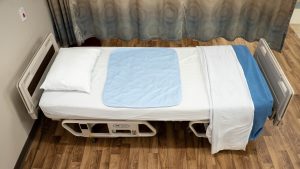
Photo by Allie Tiller is licensed under CC BY-NC 4.0
Occupied beds are beds that must be made with somebody in them. NAs will have to make occupied beds when somebody is on an “absolute bedrest” order from a doctor.
Occupied beds must be made one side at a time; NAs should raise the bed rail on one side of the bed (remember the risk of entrapment associated with bedrail use) and gently turn the person in bed to their side facing the bed rail. NAs should request assistance from a coworker if they feel unsure about making an occupied bed alone.
One side at a time; roll the bottom used linen (soiled side in) towards the person and tuck the roll against their back. Then make the first half of the bed.
After the first side of the bed has been made the NA can now raise the bedrail on the clean side of the bed before helping the person roll over onto the clean side of the bed. Once the person has rolled onto the clean side of the bed, the rest of the soiled linens can be removed and placed in the laundry bag.
The NA can gently grasp the rest of the clean linens and finish making the bed. Make sure the bed is wrinkle free and that the person’s comfort needs are tended to before leaving.
Video by Allie Tiller is licensed under CC BY-NC 4.0
A surgical bed is specifically designed for people returning from surgery on a stretcher to make the transfer from stretcher to bed as smooth as possible.
To make a surgical bed one can first make a closed bed, and then fold linens down from the head of the bed and fold up the linens at the foot of the bed. Once this fold has been completed, fanfold the linens by making pleated layers on the side of the bed opposite from where the person will transfer from the stretcher.
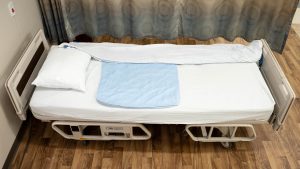
Photo by Allie Tiller is licensed under CC BY-NC 4.0
Key Takeaways
- A safe and healthy environment for a patient is one in which all of their physical and psychosocial needs are met. They are comfortable in terms of temperature, odor, light, and sound. They are emotionally calm, and experience a sense of security.
- A patient’s room will always include a bedside stand, a bed, basic equipment such as a bedpan and emesis basin, a dresser and/or closet, an over-bed table, a chair, a privacy curtain, and a call light. Rooms may have additional features depending on the facility and the needs of the patient. Always respect a patient’s personal belongings and treat them with care.
- During admission, transfer, and discharge nursing assistants are responsible for maintaining a friendly, supportive, and attentive atmosphere. They may assist the patient with becoming oriented to their new space, perform basic intake paperwork and obtain weight and vitals, and assist the patient with their personal belongings.
- Repositioning a resident appropriately is key to their health, especially when it comes to promoting circulation and preventing pressure injuries. Always communicate with a resident throughout the repositioning process. Follow the care plan.
- Beds must be smooth and wrinkle-free. Different bed-making strategies will be used for different circumstances; for examples, an “occupied bed” will be used when someone cannot get out of bed, while a “surgical bed” will be used when someone is returning from an operation. Always change wet bed linens immediately.
Comprehension Questions
1) A person is considered comfortable when they are…
a. Depressed but sleepy
b. Physically safe, free from pain, emotionally well
c. In a big soft sweater
d. Physically well but nervous about their circumstances
2) Respond to the following sentences with T (true) or F (false).
____ A resident’s room must be kept between 75- and 85-degrees Fahrenheit.
____ Odors and noise levels can have a notable impact on someone’s comfort.
____ NAs should decide how a room is lit, even if the resident disagrees. NAs know what lighting is safe and comfortable for someone.
____ All resident rooms will have a television.
____ Call lights are an important piece of equipment and must be kept within reach of the resident at all times.
3) Which pieces of equipment are always in a resident’s room? Select all that apply.
a. Dresser/closet
b. Remote control
c. Privacy curtain
d. Artwork
4) What are overbed tables used for?
a. For a convenient place to put bedpans and used linens while providing care
b. To help a person eat and drink, or do activities like use a laptop or read
c. As a decorative object
d. To give residents something to lean on when they get out of bed
5) Why is repositioning necessary for holistic person-centered care?
a. Because preventing pressure injuries and circulatory musculoskeletal complications is convenient for the healthcare team
b. Because preventing pressure injuries and circulatory musculoskeletal complications is required by law
c. Because preventing pressure injuries and circulatory musculoskeletal complications is part of meeting the full scope of a person’s needs in an attentive and dignified way
d. Because preventing pressure injuries and circulatory musculoskeletal complications can be fun
6) Which description below describes the Fowler’s position?
a. The person is lying flat on their abdomen with arms palm-up at their sides
b. The person is lying flat but they are angled so their head is lower than their feet
c. The person is lying flat on their back with their heels slightly elevated
d. The person is semi-sitting at about a 45 – 60 degree angle
7) When assisting with admitting a new resident, NAs should…
a. Exude a sense of pleasant calmness by chit chatting for a while in the intake room, especially on busier days
b. Practice kindness, patience, and empathy while taking the resident’s basic information, showing them around the facility and their room, and introducing them to neighbors
c. Practice kindness and curiosity by asking personal questions about the person’s objects
d. Keep the care planning meeting a secret so as not to worry the resident
8) A resident is expressing worry and anxiety about transferring out of the facility. How should you respond?
a. Keep saying “it’s all going to be okay”
b. End the conversation quickly because you are very busy
c. Listen thoughtfully and empathetically, be honest, and offer a comforting touch on the hand
d. Play them your new favorite song
9) A person’s bed linens are changed …
a. Only once they are too smelly for comfort
b. Every 1 – 2 days, usually on bath day, or whenever they are damp or soiled
c. When the NAs don’t like the pattern on the sheets
d. Every day no matter what
10) Respond to the following sentences with T (true) or F (false).
____ Bed linens consist of a fitted sheet, a flat sheet, a draw sheet, an aerial sheet, and sometimes a blanket.
____ Incontinence pads, waterproof pads, and disposable bed protectors can be used to minimize the impact of spills.
____ Beds should be adjusted to waist-height before being made to protect NAs’ alignment.
____ Occupied beds should be made when the person is in the shower or bathroom.
11) Write a paragraph describing the relationship between physical and emotional needs as they pertain to the resident and their room. What are some ways NAs can help residents meet their full scope of needs?
12) Mr. Jones is a new resident and is trying to get some rest. He is most comfortable with a cup of green tea after dinner to help his digestion, so after drinking his tea he retires early. Outside his room in the hall, members of the healthcare team chat because it is not yet lights-out time. Mr. Jones’ wife has recently passed away, which is why he decided to move into the residence facility. Mr. Jones sometimes needs to sleep with a light on because of regular urges to use the bathroom; sometimes he soils the bed, but rather than disturb the healthcare team he chooses to change his own clothes and sleep in his chair, and let the team address the linens in the morning. What are some factors negatively impact Mr. Jones’ comfort as he tries to rest? What are some things that NAs could do to help make Mr. Jones more comfortable?
- Nursing Assistant Chapter 3 by Chippewa Valley Technical College is licensed under a Creative Commons Attribution 4.0 International License, except where otherwise noted.. ↵
- Truitt, R. (2018, June). What Are OBRA Guidelines for Indiana Nursing Homes? https://www.truittlawoffices.com/blog/obra-guidelines/ ↵
- Truitt, R. (2018, June). What Are OBRA Guidelines for Indiana Nursing Homes? https://www.truittlawoffices.com/blog/obra-guidelines/ ↵
- Dugan, D. (2020). Nursing assisting: A foundation in caregiving (5th ed.), Chapter 10. Hartman. ↵
- There are multiple different kinds of beds. For example, an electric bed is a bed that allows for controlling the head and knee positions of the bed using a remote. Alternating pressure beds help to relieve and redistribute pressure because they are built with a series of air-sacs that can be repositioned. Alternating pressure beds can help alleviate pressure on specific areas of the body should sores or skin contusions develop, and are especially useful if a patient is difficult to reposition. High-low beds are fully adjustable beds with head, foot, and height adjustability; while all hospital beds will be height-adjustable to a degree, high-low beds are specially designed for maximum accommodation depending on the person’s care needs and the staff's ergonomic safety. ↵
- Sorrentino, S. A., & Remmert, L. N. (2019). Mosby's essentials for nursing assistants (6th ed.), Chapter 15. Elsevier. ↵
- Dugan, D. (2020). Nursing assisting: A foundation in caregiving (5th ed.), Chapter 9. Hartman. ↵
- Montague-McCown, M., Bena, J., & Burchill, C. N. (2021). Effect of Hospital Linens on Unit-Acquired Pressure Injuries for Adults in Medical ICUs: A Cluster Randomized Controlled Trial. Critical care explorations, 3(3), e0336. https://doi.org/10.1097/CCE.0000000000000336 ↵
- Admin. (2017, April). Bedmaking. Nurse Key. https://nursekey.com/bedmaking/ ↵
Devices used to assist a person with elimination when they cannot leave their bed to eliminate on a commode or in a bathroom
A small basin that resident’s can use to spit into after rinsing their mouth
Corroded skin resulting from persistent pressure in the same place on the body
Shortening of a muscle
How different parts of someone's body work together
The process of becoming a new patient at a facility
Moving to a new living space within a facility, or moving to a new facility
The process of leaving a facility and transferring care to home
A detailed written document outlining what each resident needs for high-quality care. Each care plan will be different, and will be tailored to the unique situation of the resident.
Gatherings of the nursing and care teams to discuss ongoing care assessment, updated care goals, and strategies for ensuring a resident's highest quality of life. Patients and their families have a right to participate in care conferences.
Caregiving that is well-organized, correctly executed, and that maintains effective communication among all members of the care team, including the person's family.
The steps followed every time after completing a care task, including performing hand hygiene and making sure the resident is comfortable.
